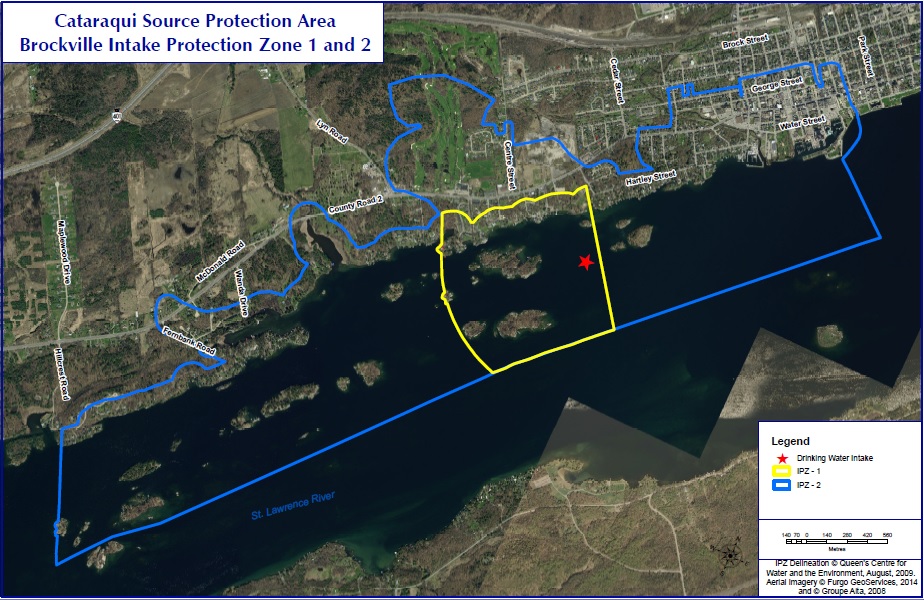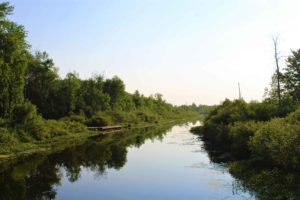On This Page:
- What is source water?
- Why is source water protection important?
- What is the Township’s role? How is the Township involved?
- What is the Brockville Intake Protection Zone?
- What is a drinking water threat?
- What can you do to help?
- Further information on source water protection
What is source water?
Source water is the untreated water in lakes and rivers, and in underground aquifers, that people use for drinking water.
Why is source water protection important?
Source water protection contributes to the health of humans and ecosystems, as well as benefiting tourism and recreation. Protecting the sources of our drinking water ensures that there is enough safe water for all our existing and future uses.
- Water treatment isn’t always enough: water treatment systems cannot always remove all contaminants (including chemicals such as liquid fuels and solvents).
- Prevention saves money: it is much easier and cheaper to keep water clean than it is to try and clean it up after it has been polluted. For example, a 2010 spill from a home heating oil tank in eastern Ontario cost approximately $1 million to clean up, while preventative changes to the tank and supply lines could have been completed for as little as $1500.
- Contamination can ruin a water source forever. If it is not possible to clean up the water after it has been contaminated, water supplies will have to be shut down. In the 1990’s a new drinking water supply had to be found for the community of Manotick because the groundwater was polluted by a chemical spill from a dry cleaning business. Safe drinking water had to be piped from the City of Ottawa at a significant cost.
- Also, all homes outside the City of Brockville limits are normally on private well and septic systems, yet homes on and close to County Rd. 2, west of Brockville, had to be connected to the City water supply early in 2000 to overcome a problem with road-salt contamination of well water aquifers.
What is the Township’s role? How is the Township involved?
- The Ontario Clean Water Act, 2006 established local source protection committees responsible for developing source protection plans. The Cataraqui Source Protection Authority is one of three Authorities established covering the Township of Elizabethtown-Kitley (Rideau Valley/Mississippi and South Nation). The Act set out the guidelines for the source water protection plans which include education and outreach policies that municipalities and other bodies must implement to assist in the protection of drinking water sources.
- Source water protection also speaks directly to both the Township’s vision and mission statements by working toward the protection of the Township’s sensitive groundwater and to the City of Brockville’s Intake Protection Zone which is located within the Township’s boundaries.
- The City’s municipal drinking water system provides municipally piped water to the residents of the City as well as to select properties within the Township, west of the City limits.
What is the Brockville Intake Protection Zone?
- The Brockville water treatment plant draws water from the St. Lawrence River via an intake pipe. This source of water is treated and distributed to about 22,000 residents and businesses in the City of Brockville and about 1,000 residents in the Township of Elizabethtown-Kitley. The intake pipe is located about 300 metres offshore at a depth of 10.5 metres.
- As per the Clean Water Act, an Intake Protection Zone (IPZ) is the land and water around an intake pipe that supplies drinking water to a municipal residential system, where actions must or should be taken to protect the drinking water supply.
- Brockville IPZ is made of two parts:
- IPZ-1 is the area closest to the intake pipe and is a set distance which extends one kilometre upstream and 120 metres onto the shore.
- IPZ-2 includes the on and offshore areas where flowing water and any pollution would reach the intake pipe within two hours.

What is a drinking water threat?
A drinking water threat is an activity that has the potential to harm the quality or quantity of water that is used as a source of drinking water.
Some common threats include:
- Hazardous Waste Spills/Accidents
- Storage of Hazardous and Liquid Wastes
- Septic
- Salt
- Well Testing
What can you do to help?
Here are the top ten actions you can take to help keep drinking water sources clean in your community:
- Handle and dispose of waste properly:
- Reduce your waste production
- Use local hazardous waste collection programs
- Pick up pet waste
- Maintain heating oil tanks and fill lines:
- Inspect your oil tank regularly
- Upgrade to a modern fuel tank
- Install a drip pan and oil line/gauge protectors
- Maintain and use septic systems properly:
- Know the location of your tank and septic beds and protect it from damage
- Have the tank pumped out every three to five years
- Conserve water
- Avoid the use of bleach/harsh cleaning products
- Maintain wells:
- Inspect your well at least once a year
- Keep potential pollutants (i.e. livestock, septic systems, fuel sources, gardens) away from your well
- Test your well water regularly for bacterial contamination
- Hire a licensed well contractor to upgrade your well or properly plug unused wells:
- Be sure to use a Ministry of the Environment and Climate Change licensed contractor for well upgrades and to properly decommission an unused well
- Avoid or limit the use of road salt:
- Wear sturdy footwear
- Switch to snow tires
- Use traction aids (i.e. sand)
- Practice smart salt application
- Stop snow and ice from accumulating by shoveling and sweeping as soon as possible after or during a snowfall
- Pile snow away from storm sewers, so that it will not run across paved surfaces when it melts. Snow may melt during the day and freeze on the pavement at night requiring more salt
- Practice smart agriculture:
- Fence livestock away from watercourses
- Practice conservation tillage
- Mix/apply chemicals away from water bodies
- Follow the manufacturer’s directions for storage and application methods
- Establish and maintain a buffer zone near watercourses
- Practice water conservation:
- Use a rain barrel to water your garden
- Install low flow shower heads and toilets
- Fix leaking taps
- Use green products for:
- Household cleaning
- Personal care
- Lawn care
- Work together to find opportunities in your community to better protect water.
Protecting our drinking water sources can be easy. Small actions make a difference. Your actions matter.
For further information on source water protection, view the resources below:
CRCA – Cataraqui Region Conservation Authority
Mississippi-Rideau Source Water Protection
Rideau Valley Conservation Authority
South Nation Conservation Authority
http://www.yourdrinkingwater.ca/
www.nation.on.ca/water/source-water-protection
Conservation Ontario

